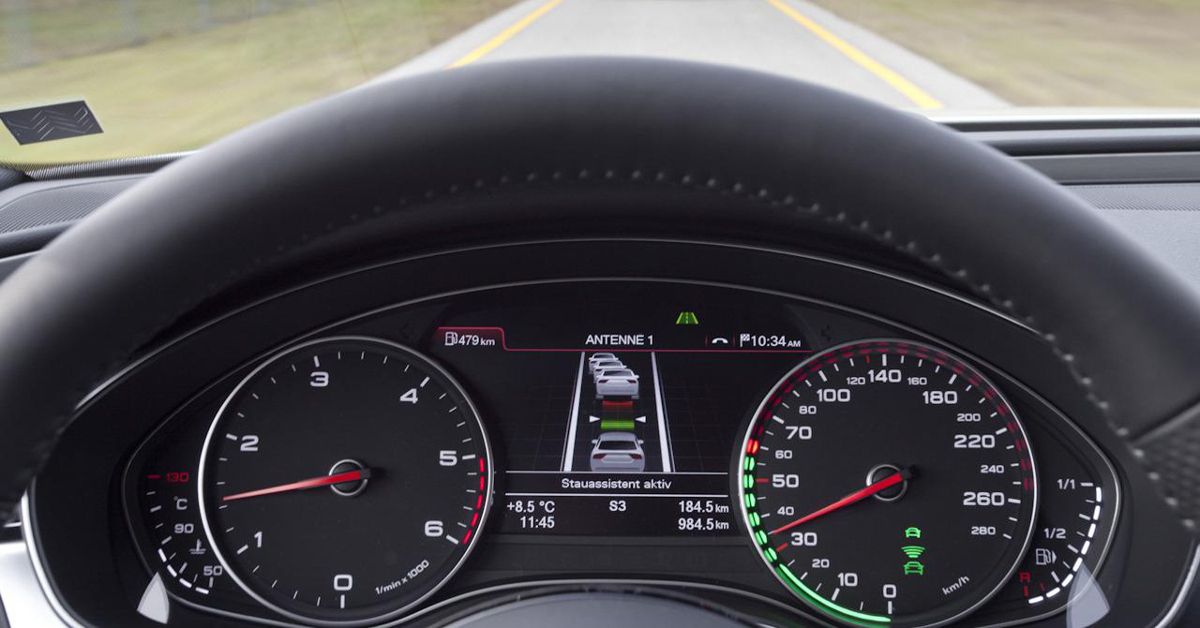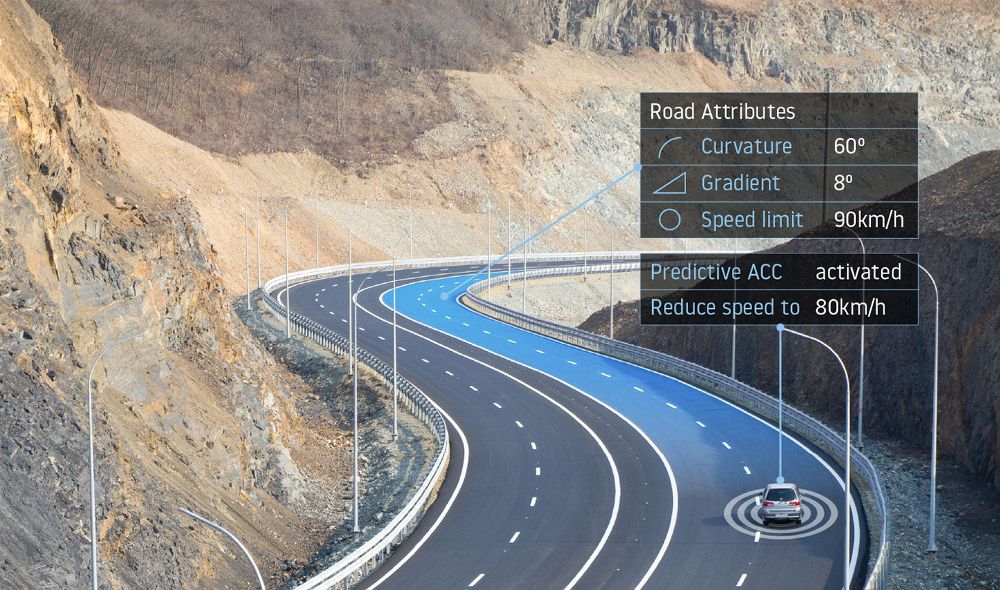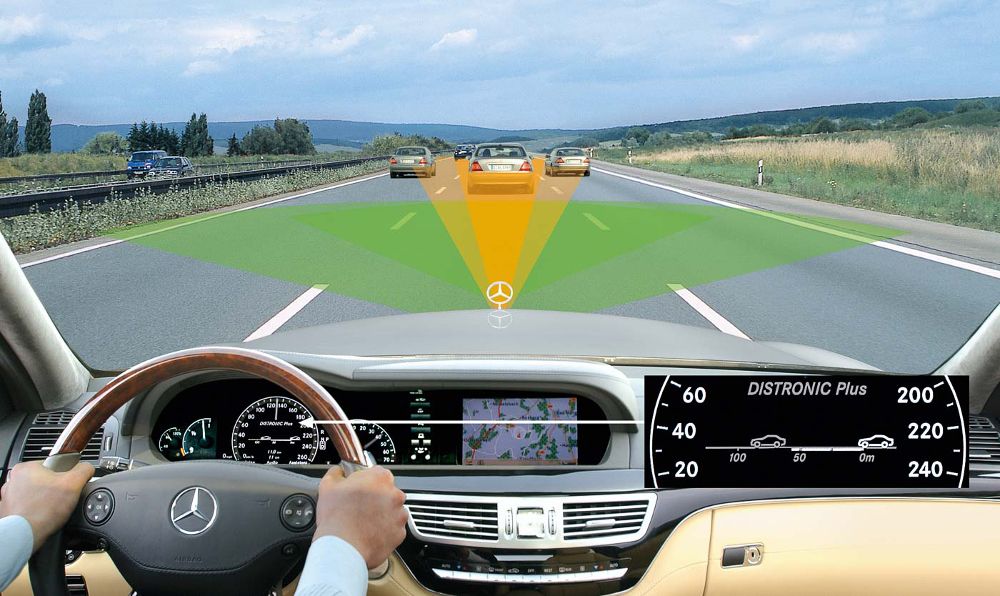Often found on luxury brands like Audi, Adaptive Cruise Control works by automatically adjusting the car’s speed to stay within set limits and keep a safe following distance to the car in front.
Adaptive cruise control (ACC) can best be seen as a smart version of cruise control systems such as the "Speedostat," fitted to the 1958 Chrysler Imperial and known as “Auto-Pilot.” This early system worked out the ground speed via the rotating speedometer cable and used a bi-directional screw-drive electric motor to adjust the throttle position. Cadillac ultimately renamed the device "Cruise Control."
While the role of ACC remains aligned to that of the early cruise control, modern electronics and sensors add a functionality that gives it a set-and-forget capability.
The system works by fusing data from an array of sensors, such as stereo-cameras, medium-range radar, and LIDAR with intelligent MEMS (micro-electro-mechanical-systems) inertial positioning sensors, to give the car a real-time 3D picture of its surroundings.
Using this spatial perception, ACC monitors the vehicle ahead to maintain a safe distance. Depending on the driver’s penchant, the system will automatically speed up, or slow the car, as required. As an Active Driver Assist System (ADAS) the driver can tailor the system’s response to their driving preferences, such as the distance to the car in front and driving mode – for instance, economical, sporty, or comfortable.
What is more, depending on the manufacturer ACC’s functionality can be enhanced to enable other ADAS features.
This Is How Adaptive Cruise Control Works In Other Use Cases
Enabled by the latest sensor technologies, intelligent ACC systems can deliver way more value than merely maintaining a safe following speed and distance. It’s really up to the manufacturer, to decide on what system functionality is appropriate.
Even systems found on entry-level vehicles incorporate Stop and Go cruise control, to enhance the driving experience in congested traffic. This enhancement allows the car to autonomously brake and accelerate, in stop-start traffic.
Another easily integrated functionality is eco-cruise that optimizes fuel and electricity consumption. When engaged, eco-mode controls the set speed to reduce the amount of energy expended – whether electricity or fuel.
In more advanced systems where the vehicle is equipped with MEMS, and LIDAR manufacturers are beginning to adapt the ACC to autonomously regulate the vehicle’s speed when negotiating curves. Combining MEMS with 3D maps and LIDAR, intelligent cruise control takes the vehicle’s dynamics into account when calculating the safe and comfortable speed for any section of road. Changing driving modes from, say, eco to sport automatically updates the vehicle dynamics, and thus the way you drive.
The final piece of the puzzle to unleash the full power of ACC is vehicle connectivity. V2X (vehicle to everything) connectivity gives the system the ability to predict road hazards even before the driver sees them. By being connected to other cars and infrastructure, the vehicle will receive advanced warning of a problem ahead, thereby allowing the ACC to proactively respond.
Understanding how adaptive cruise control works may, at face value, seem to be a good idea that is simple enough for any driver to use. Unfortunately, that is not the case.
The Dangers Associated With How Adaptive Cruise Control Works
The problem with ACC doesn’t lie with the complexity of the system, but rather with its inconsistent and unregulated integration with other ADAS systems by the OEMs.
The inconsistency in anticipated performance, coupled with the confusing terminology used to label adaptive cruise control systems is very worrying.
The problem is so serious that in 2019 several senators raised concerns around consumers’ understanding of what ADAS and autonomous vehicle technologies are capable of. Responding, NHTSA called on manufacturers to clearly make consumers aware of the limits of the technology, and adopt a common nomenclature and standards.
Highlighting the problem with inconsistent terminology, the AAA found in January 2020 that the 34 vehicle brands surveyed used 20 different names for adaptive cruise control. To address the problem AAA, Consumer Reports, the National Safety Council, and J.D. Power have agreed to work towards adopting a common naming for ADAS technology.
The problem, however, runs deeper. It’s not uncommon for some manufacturers to bundle systems such as Autonomous Emergency Braking (AEB) and ACC together in a branded ADAS system. The problem is that, because ACC and AEB are similar in operation but vastly different functions, it is very easy for an unsuspecting driver to misinterpret the vehicle’s capability – with potentially fatal consequences.
Adopting standards throughout the industry will reduce the cost and complexity of all ADAS systems and empower consumers by clearly defining the constraints of features such as ACC and AEB. These standards are currently being shaped by collaboration between government regulators and engineering organizations, such as SAE International, and other stakeholders.
Understanding how adaptive cruise control works is more than pressing a button and getting the car to do the tedious work of following the car in front. In the background, ACC could be exercising far more control than many drivers realize.



